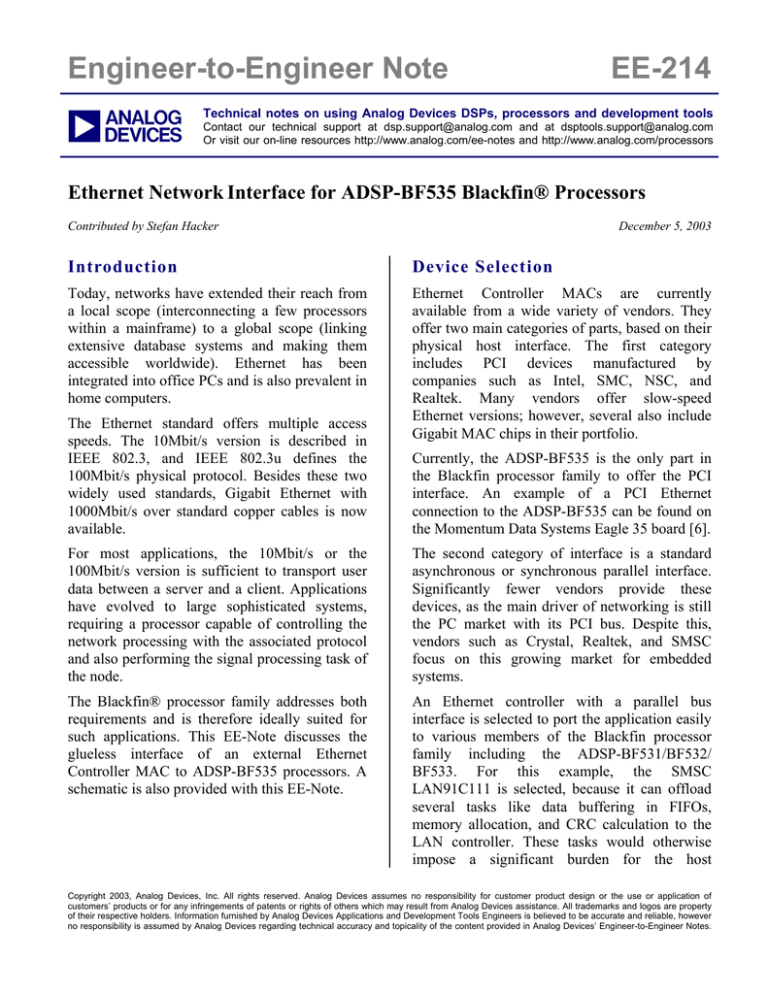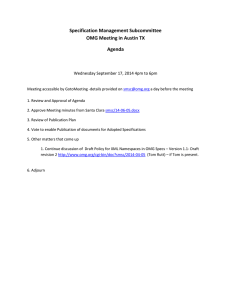a Engineer-to-Engineer Note EE-214
advertisement

Engineer-to-Engineer Note a EE-214 Technical notes on using Analog Devices DSPs, processors and development tools Contact our technical support at dsp.support@analog.com and at dsptools.support@analog.com Or visit our on-line resources http://www.analog.com/ee-notes and http://www.analog.com/processors Ethernet Network Interface for ADSP-BF535 Blackfin® Processors Contributed by Stefan Hacker December 5, 2003 Introduction Device Selection Today, networks have extended their reach from a local scope (interconnecting a few processors within a mainframe) to a global scope (linking extensive database systems and making them accessible worldwide). Ethernet has been integrated into office PCs and is also prevalent in home computers. Ethernet Controller MACs are currently available from a wide variety of vendors. They offer two main categories of parts, based on their physical host interface. The first category includes PCI devices manufactured by companies such as Intel, SMC, NSC, and Realtek. Many vendors offer slow-speed Ethernet versions; however, several also include Gigabit MAC chips in their portfolio. The Ethernet standard offers multiple access speeds. The 10Mbit/s version is described in IEEE 802.3, and IEEE 802.3u defines the 100Mbit/s physical protocol. Besides these two widely used standards, Gigabit Ethernet with 1000Mbit/s over standard copper cables is now available. Currently, the ADSP-BF535 is the only part in the Blackfin processor family to offer the PCI interface. An example of a PCI Ethernet connection to the ADSP-BF535 can be found on the Momentum Data Systems Eagle 35 board [6]. For most applications, the 10Mbit/s or the 100Mbit/s version is sufficient to transport user data between a server and a client. Applications have evolved to large sophisticated systems, requiring a processor capable of controlling the network processing with the associated protocol and also performing the signal processing task of the node. The second category of interface is a standard asynchronous or synchronous parallel interface. Significantly fewer vendors provide these devices, as the main driver of networking is still the PC market with its PCI bus. Despite this, vendors such as Crystal, Realtek, and SMSC focus on this growing market for embedded systems. The Blackfin® processor family addresses both requirements and is therefore ideally suited for such applications. This EE-Note discusses the glueless interface of an external Ethernet Controller MAC to ADSP-BF535 processors. A schematic is also provided with this EE-Note. An Ethernet controller with a parallel bus interface is selected to port the application easily to various members of the Blackfin processor family including the ADSP-BF531/BF532/ BF533. For this example, the SMSC LAN91C111 is selected, because it can offload several tasks like data buffering in FIFOs, memory allocation, and CRC calculation to the LAN controller. These tasks would otherwise impose a significant burden for the host Copyright 2003, Analog Devices, Inc. All rights reserved. Analog Devices assumes no responsibility for customer product design or the use or application of customers’ products or for any infringements of patents or rights of others which may result from Analog Devices assistance. All trademarks and logos are property of their respective holders. Information furnished by Analog Devices Applications and Development Tools Engineers is believed to be accurate and reliable, however no responsibility is assumed by Analog Devices regarding technical accuracy and topicality of the content provided in Analog Devices’ Engineer-to-Engineer Notes. a processor. The SMSC LAN91C111 has a 3.3Vcompatible 16- or 32-bit-wide host interface, which can be operated asynchronously or synchronously. This ensures that it can be attached to all members of the Blackfin processor family. Electrical Interface In this schematic example for the ADSP-BF535, the parallel interface uses the 32-bit data path of the processor to obtain the highest bandwidth between the host and the LAN controller for best performance. Additionally, the asynchronous interface is selected, as it gives a more relaxed timing than the synchronous operation, which targets embedded PC systems with a VESA local bus running at 40MHz or slower. With the data sheet of the SMSC LAN91C111 [3] and help from SMSC AN9.6 application note [4] (see www.smsc.com for updates), the pins for the asynchronous address and data bus are quickly identified. The data bus can be wired directly (e.g., connect D0 of the ADSP-BF535 to D0 of the SMSC LAN91C111, etc.). Attention must be paid to the address translation of the ADSP-BF535 on the external interface: if the 32bit data bus is used, A2 will be the lowest address bit driven externally. The individual byte is then activated through dedicated byte enable lines (/ABEx). The LAN 91C111 is also a 32-bit addressing device and therefore its lowest address line used is A2. Only in the 16-bit interface, /ABE3 of the ADSP-BF535 must be wired to A1 of the LAN controller. Otherwise, this pin can be left floating. For the control side of the interface, only a few lines need to be interconnected between the ADSP-BF535 and the LAN 91C111. Here it is important to distinguish between the signals of the synchronous interface and those of the asynchronous interface. Again, with help of SMSC’s AN9.6 application note, only few strobes remain. With the ADSP-BF535 continuously driving the address lines during the access, /ADS can be pulled low and /AEN will connect to the memory strobe of the Blackfin processor. The last important item is the active high RESET signal of the SMSC LAN91C111. The design must either provide a reset generator with an active high and low output for the ADSP-BF535 or an inverter is needed between the power-on reset signal driven into ADSP-BF535 and the one for the SMSC. Physical Ethernet Interface Besides the host interface, the SMSC LAN91C111 also requires an electrical interface to the Ethernet media. The 100Mbit/s of IEE802.3u are only defined for twisted pair wiring, so only a RJ45 jack for the network cable has to be installed on the board. For the physical interface, you can decide between the integrated PHY of the SMSC LAN91C111 or an external one. To reduce the overall device count, only the internal PHY is used, especially as it matches the 100Mbit/s in IEEE 802.3u specifications. In addition to the PHY, impulse transformers, (sometimes called magnetics), are required to realize the electrical interface between the 3.3V device and the Ethernet media. The SMSC LAN91C111 allows a wide variety of mangnetics for the line interface. Devices with turn ratios of 1:1 for TX and RX are available from many vendors. To reduce the device count, we selected the RJ-45 Fastjack HF-J11-2450E with integrated magnetics, manufactured by HALO electronics [5]. Schematics The interface requires only few additional passive devices to provide compatibility for 16or 32-bit host processors, which is given as population option 1. All interface connections between the SMSC LAN91C111 and the ADSPBF535 can be seen in Figure 1. Ethernet Network Interface for ADSP-BF535 Blackfin® Processors (EE-214) Page 2 of 4 a Figure 1: Interface ADSP-BF535 to SMSC LAN91C111 Ethernet Network Interface for ADSP-BF535 Blackfin® Processors (EE-214) Page 3 of 4 a References http://www.analog.com [1] ADSP-BF535 Blackfin Processor Hardware Reference. Rev. 2.0. April 2003. Analog Devices Inc. [2] ADSP-BF535 Data Sheet. Rev. 0, October 2003. Analog Devices Inc. http://www.smsc.com [3] SMSC LAN91C111 Datasheet Rev. B, July 2003. SMSC Corporation [4] SMSC LAN91C111 32/16/8-Bit Three-In-One Fast Ethernet Controller (AN 9.6). May 2002. SMSC Corporation http://www.haloelectronics.com [5] FastJackTM Ethernet Connector family. Halo Electronics Inc. http://www.mds.com [6] Eagle-35 Blackfin DSP System Development Platform. Rev. 3h, May 2003. Momentum Data Systems Document History Version Description December 05, 2003 by S.Hacker. Initial Release Ethernet Network Interface for ADSP-BF535 Blackfin® Processors (EE-214) Page 4 of 4




